Don’t let those backyard corners go to waste!
Corner gardens are fantastic opportunities to enhance curb appeal and showcase your landscape.
Beyond just looking good, they can be hardworking spaces for growing vegetables and herbs, or transformed into inviting oases with seating for relaxation outdoors.
We’ve gathered some of the best ideas to help you turn any unused corner, large or small, into an eye-catching feature.
Explore the inspiration below!
Create Contrast
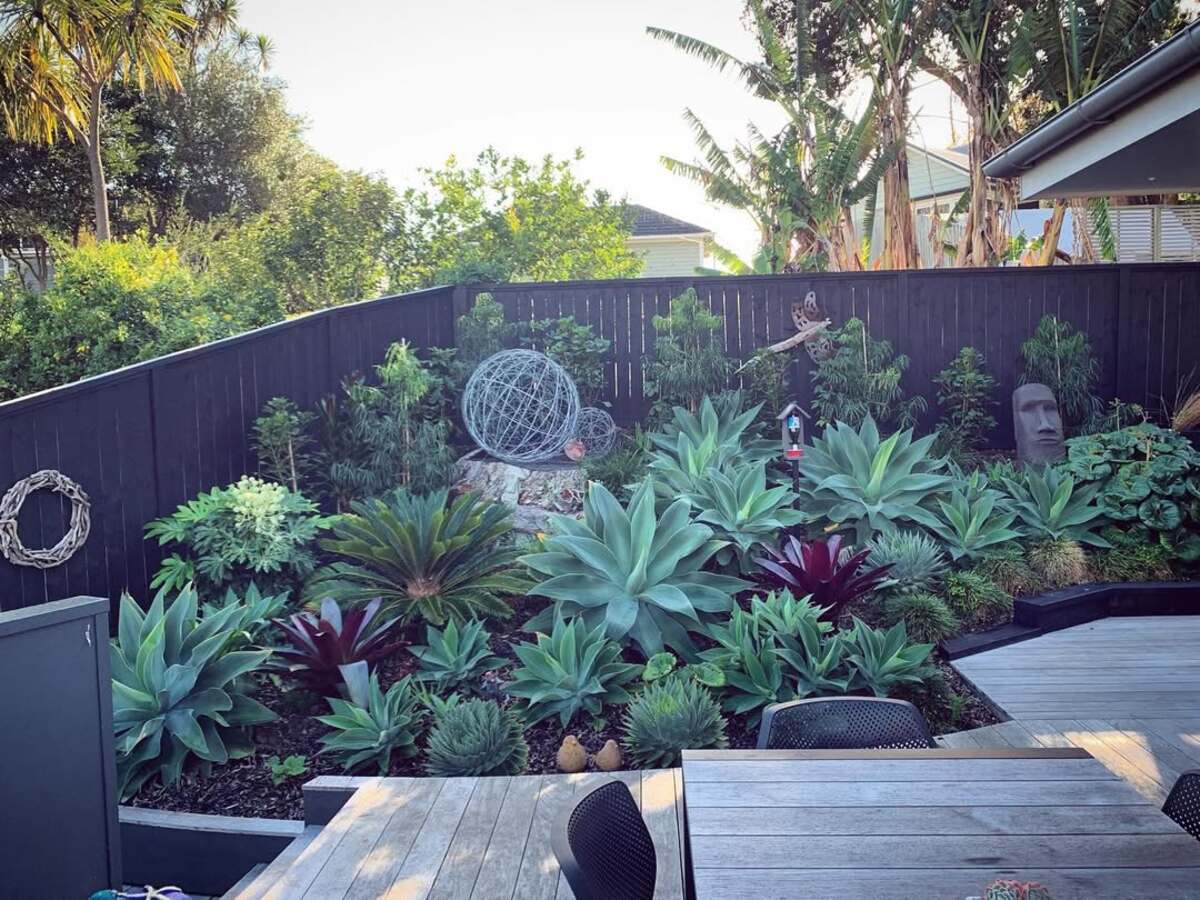
This neutral corner garden showcases a wonderful collection of green foliage.
The garden is set against a black fence, creating a lovely contrast, and includes some interesting plants such as agave, bromeliad, cycad, and spiral aloe.
A wine bottle feeder, moai statue, and several other garden ornaments help further customize the area.
A patio deck with a seating area designates a place to sit and enjoy the beauty and color of the corner garden.
Build a Patio Retreat
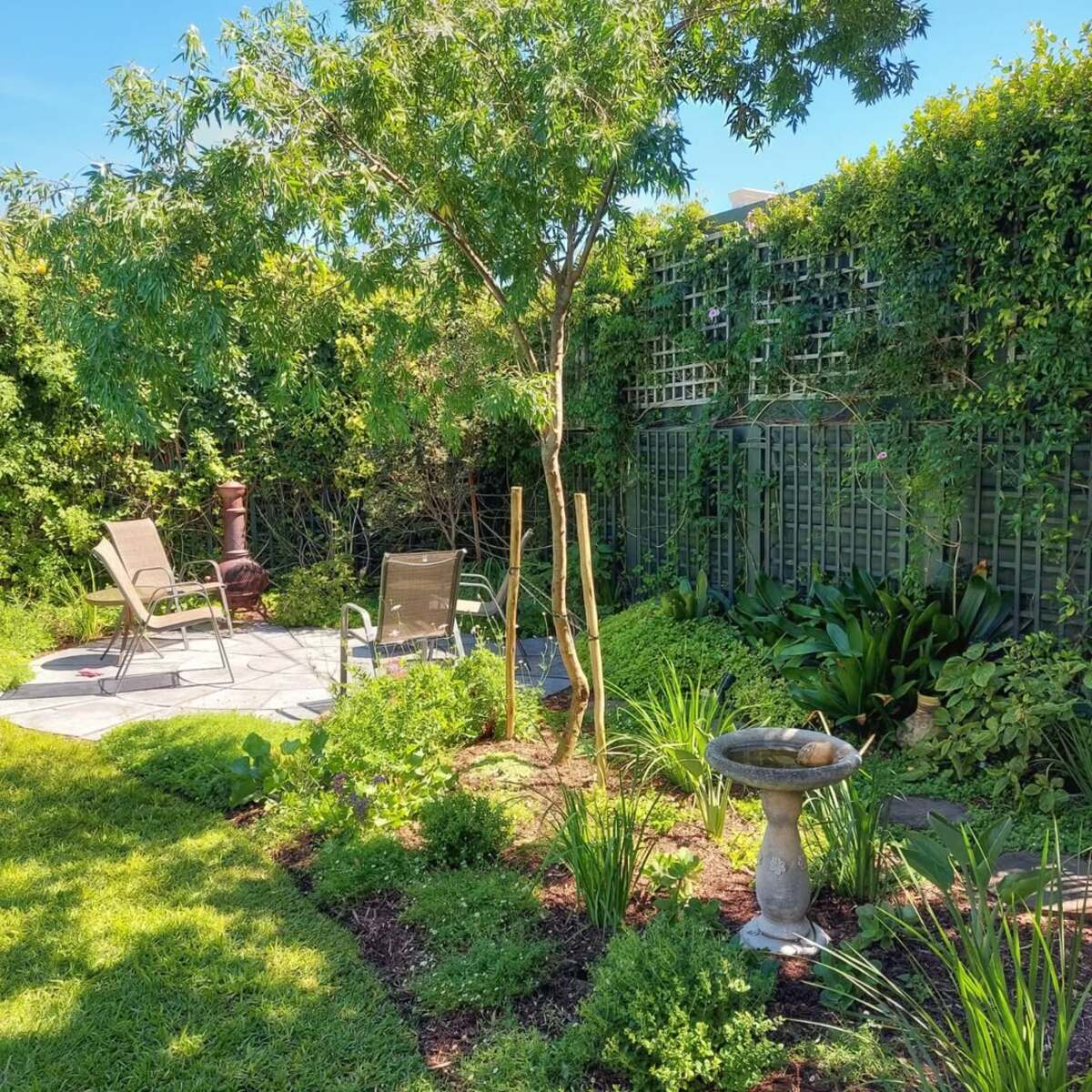
If you have a larger space in your backyard that needs to be filled, a corner garden can be the perfect idea.
Vining plants spruce up the lattice fences here, while the corner garden sets off the small patio.
The patio has a couple of seats and a chiminea fire pit that turns the space into a personal retreat where you can gather, relax, and enjoy nature.
Go for Container Planters
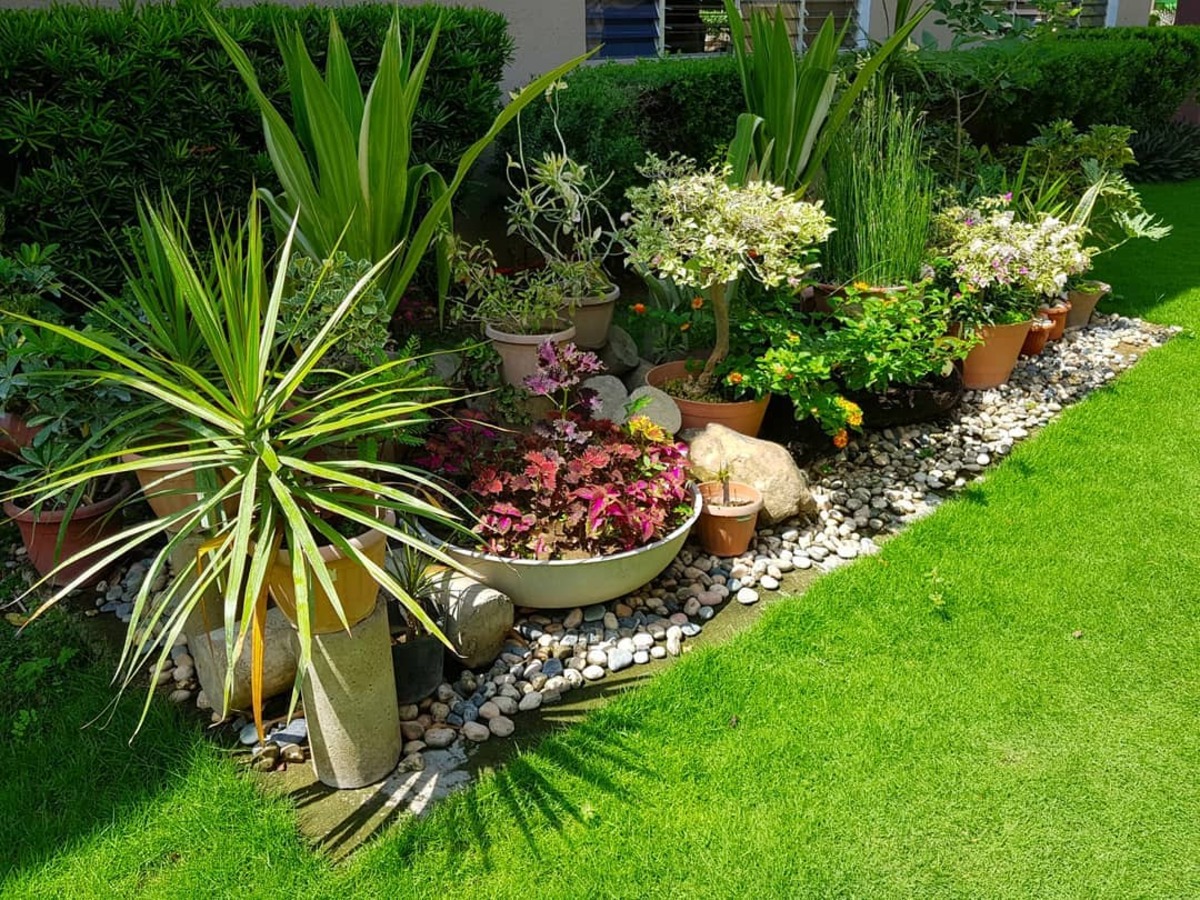
No matter how massive or small your space is, you can always create a corner garden with pots and planters.
Here, terracotta pots of various colors, sizes, and shapes were used, creating an intriguing, texture-rich corner garden.
The potted plants lie on a pebble foundation bordered by a neat lawn and a well-manicured privet hedge, giving the corner garden a natural yet formal feel.
Add some Stony Elegance
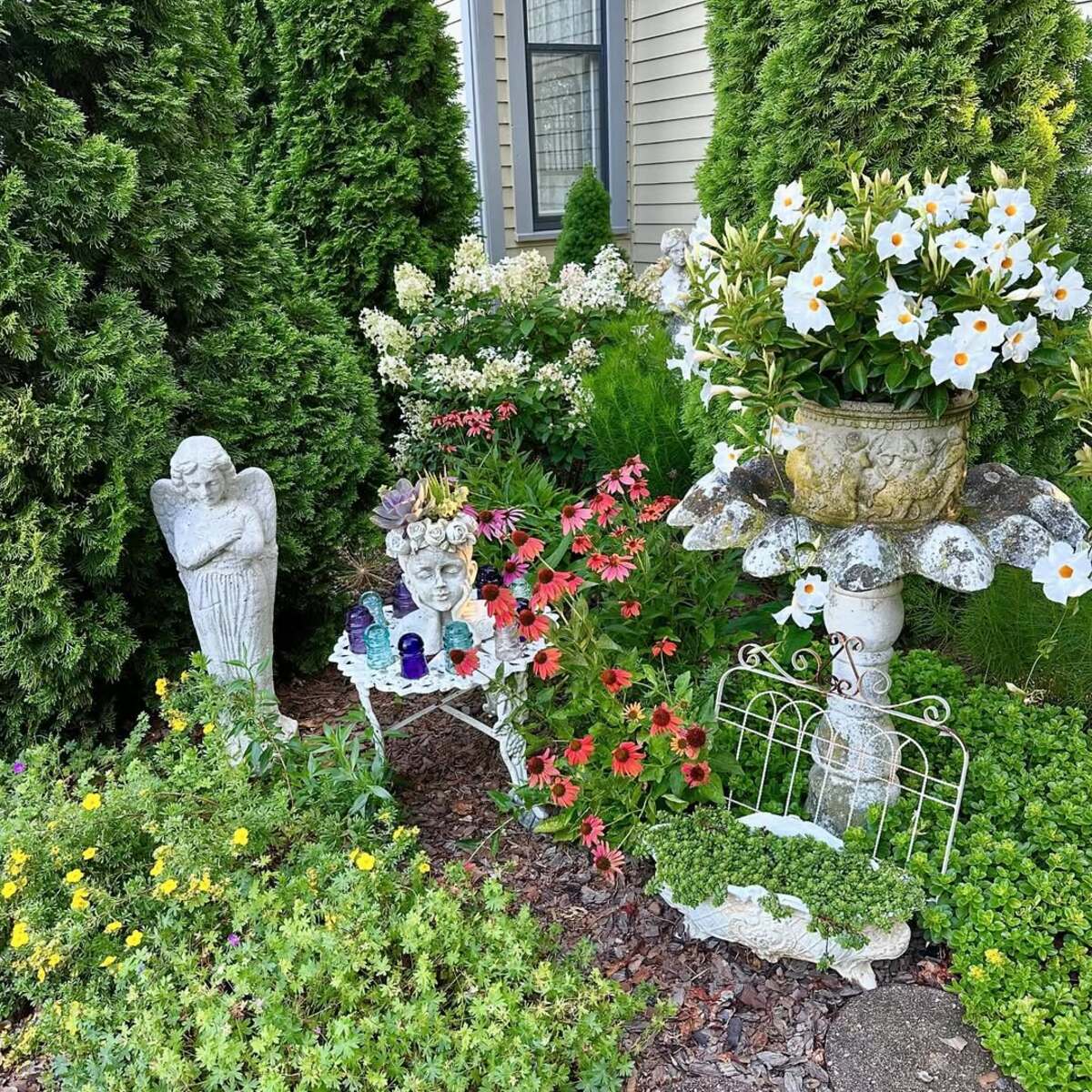
This corner garden doesn’t occupy much space but still packs a punch.
The garden starts out with small yellow coreopsis flowers in the front, red coneflowers and white Mandevilla in the middle, while some white hydrangeas sit slightly behind, all framed by large evergreen trees.
The statues, plant stands, and other garden ornaments at the center of the arrangement make the layers of plants in the corner garden really unique, with a mulch bed adding a lovely feel to the entire space.
Tuck it Away
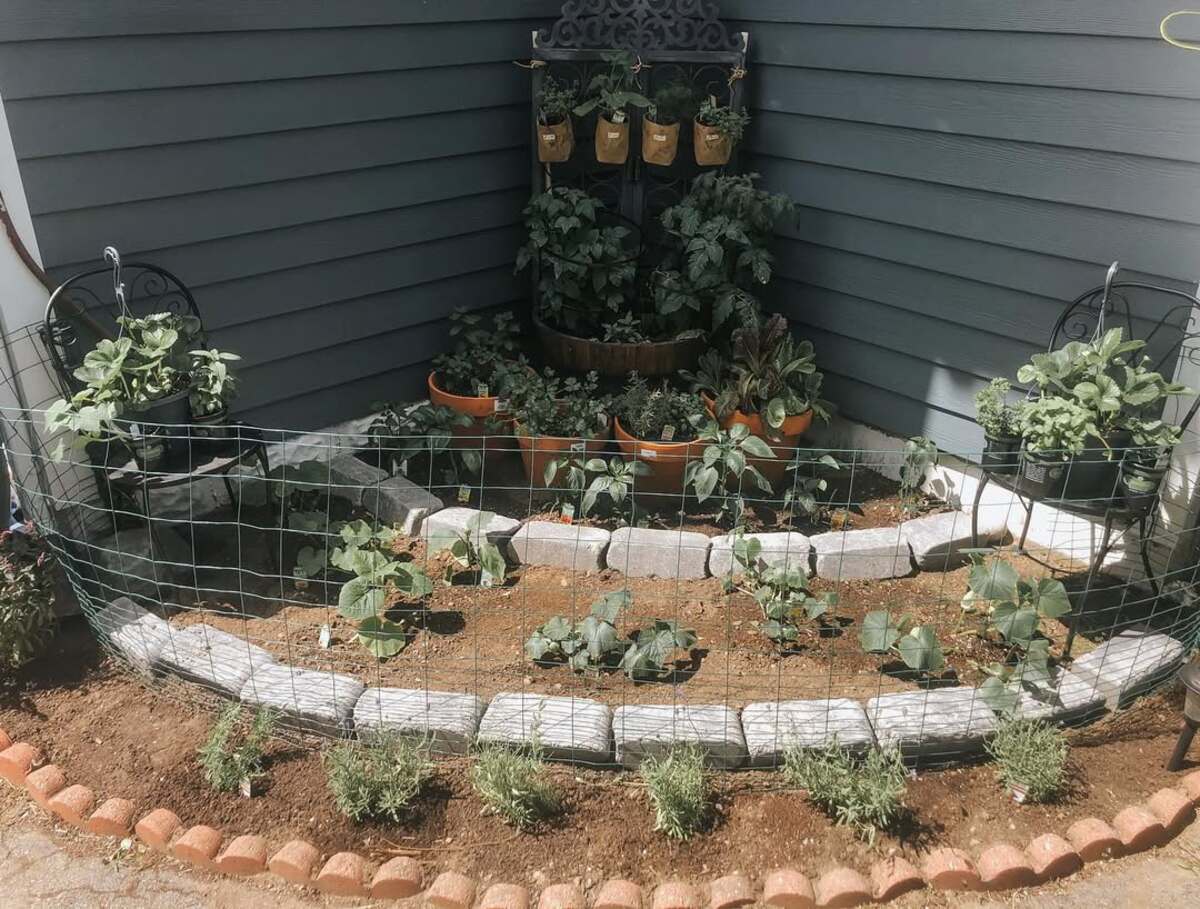
A corner vegetable garden that goes up? I see no better way to utilize a small space along your property line!
The layout here provides ample space to plant your favorite vegetables and herbs.
The corner garden is slightly terraced with decorative edging and bricks, with a wire fence keeping any invasive animals away.
A recycled pallet creates a vertical garden at the corner that not only saves space but also incorporates a lot of interest in the area.
Bring Interest with a Tree
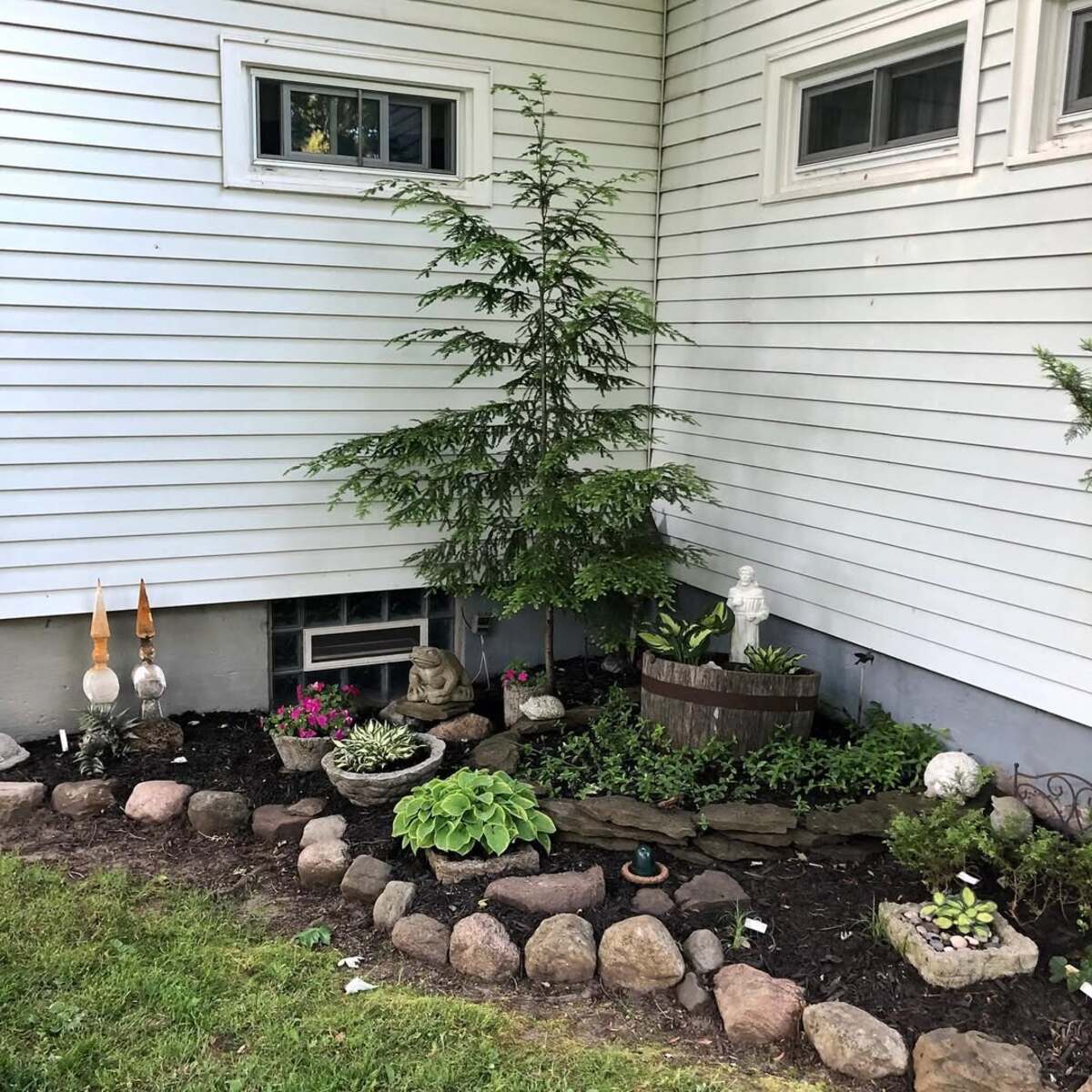
Here, a small rock border was used to cleverly tuck away a garden in a corner formed by the house.
You can add plants, trees, and flowers, such as impatiens, hostas, Eastern hemlock, boxwood used here, or even vegetables, whether in-ground or planters.
A layer of black mulch contrasts with the facade and keeps the weeds at bay, while several garden ornaments complete the look.
Build a Raised Bed
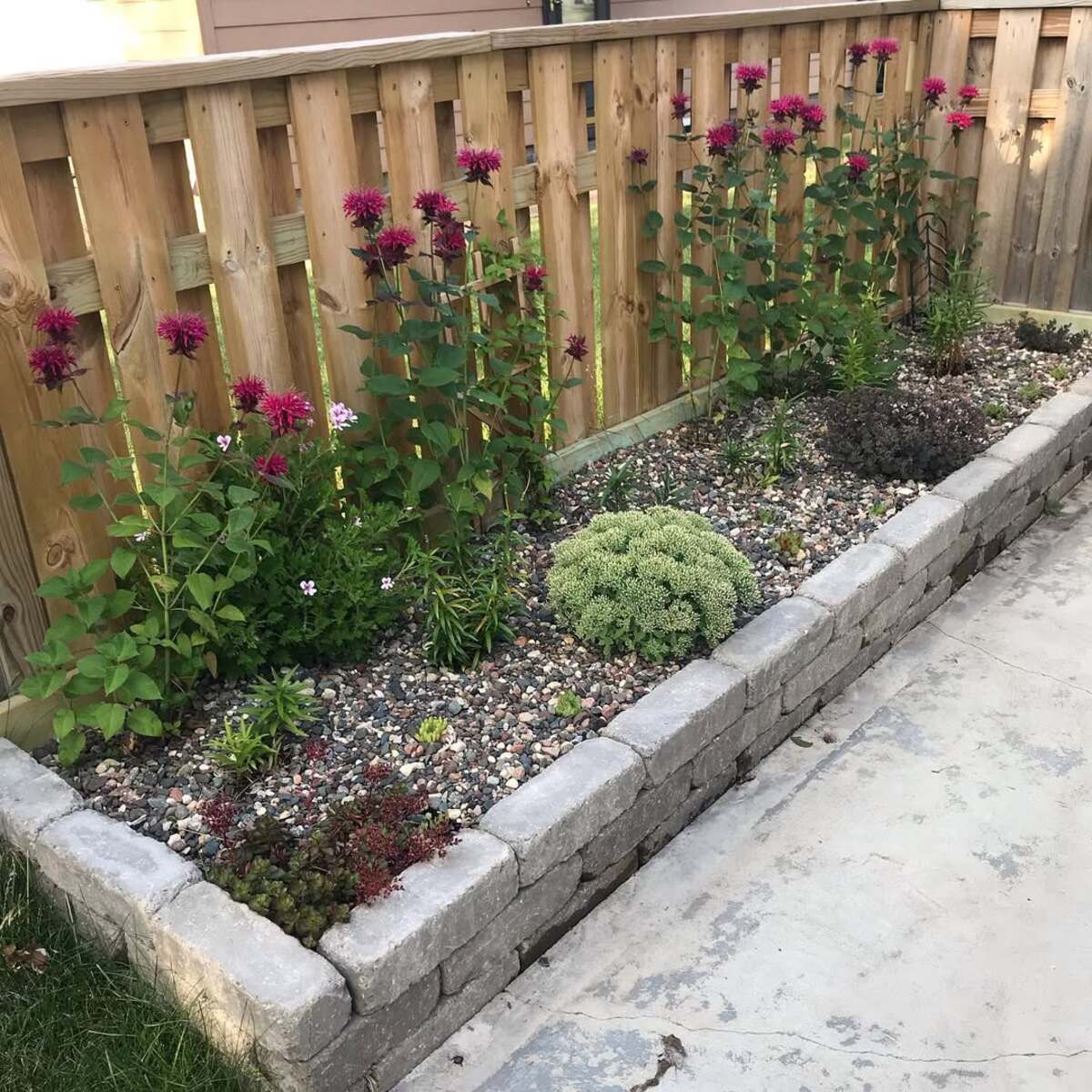
Take your corner garden off the ground with a raised bed.
Here, stacked concrete bricks create a rustic raised bed, making it easier to grow and tend to plants and flowers.
Small rocks form the flower bed and complement the gray rocky theme for a continuous look, with bee balms, sedum, and heuchera ensuring the space doesn’t feel drab.
Curate a Wonderful Display with Trees
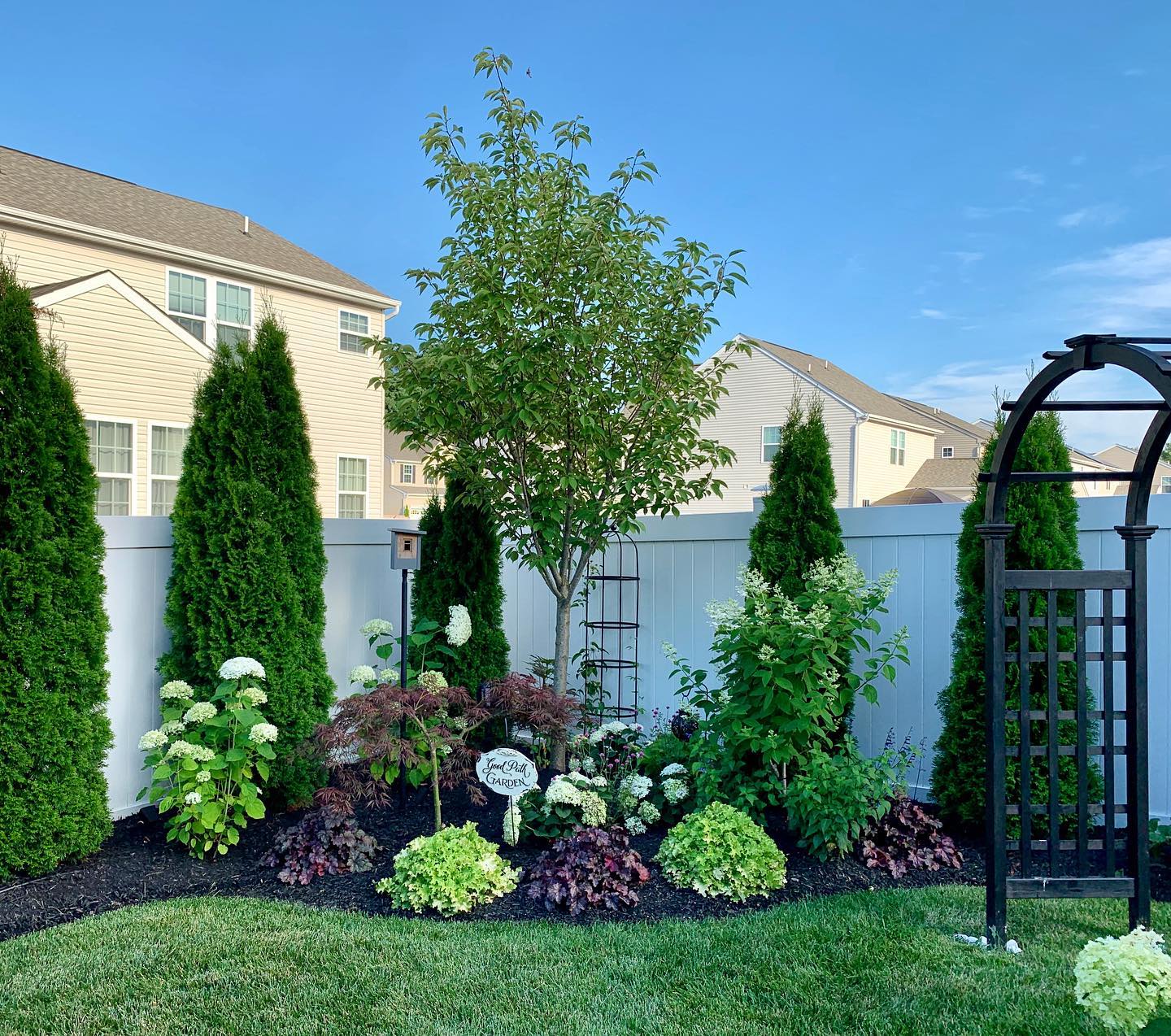
The Thuja occidentalis lining up the wall in this idea create a delightful sense of movement and add height to the corner garden.
The garden itself features a Pyrus calleryana tree surrounded by hydrangeas, peonies, spirea, Japanese maple, and hostas for an attractive display.
A birdhouse welcomes feathery friends, while a garden sign personalizes the space.
Practical Corner Garden
:max_bytes(150000):strip_icc():format(webp)/jplandscapedesignltd-25a7b51d576a4151a46e81e5b7a8ffff.jpg) @jlandscapedesigltd / Instagram
@jlandscapedesigltd / Instagram
This corner garden idea can be used anywhere in your yard, and this one is cleverly tucked away in a corner formed by the house.
You can add plants and flowers to this small garden or even vegetables.
Mulch is used to keep the weeds away and brick edging keeps everything tidy.
Shady Corner Garden
:max_bytes(150000):strip_icc():format(webp)/sixat21-c8b31a00ecf84756bae47d34f35fda4a.jpg) @sixat21 / Instagram
@sixat21 / Instagram
This beautiful corner garden designed by Yvonne Purcell really takes the idea to the next level.
There’s a trellis, potting bench, plants, and even vines that make up the garden.
She picked a shady corner to keep her plants protected from the hot summer sun, and the results were dreamy.
Corner Garden Cedar Planter Boxes
This corner garden fits in where the privacy fence meets in the backyard.
This is a perfect area for a corner garden.
With Love, Mercedes has done this with cedar planter boxes that can be filled with whatever you like.
Pavers and rocks help further customize the area.
Benches and Firepit Corner Garden
Delia Creates had a corner garden idea that’s perfect if you have a larger space that you need to fill.
Flower beds set off with garden edging and raised beds surround a fire pit that has plenty of seating for everyone in the family.
It makes a corner that not only looks great but provides a place to gather and relax.
Vertical Garden
:max_bytes(150000):strip_icc():format(webp)/sugarandcloth-527557d7fd854c5faa6601db44cc155d.jpg)
Perfect for a small corner, Ashley from Sugar & Cloth has built a vertical garden that can be used for herbs or vegetables.
It not only saves space, but it adds a lot of interest to the area.
Decorative stepping stones have also been added as well as some potted and hanging plants.
Tropical Garden Corner
The Kiwi Home has taken an unused corner of the backyard and created an inspiring corner garden.
Raised planters showcase tropical plants, sitting on a layer of gravel.
A couple of chairs and a table are there too, making it a great place to relax and enjoy your garden.
Urban Chill Out
:max_bytes(150000):strip_icc():format(webp)/antoniaschofield-4db5985b8b7248dc946862dd8cff2f45.jpg) Antonia Schofield Garden Design
Antonia Schofield Garden Design
Take this corner garden idea from Antonia Schofield Garden Design and make it a reality.
This corner space is packed with potted trees, plants, flowers, and some raised planter boxes.
There’s even a small bench so you can relax and enjoy all your hard work.
Full Corner Garden
:max_bytes(150000):strip_icc():format(webp)/jaysgardenjournal-4ee1ce7d744d4d4e9a9ea876edca5c02.jpg) @jaysgardenjournal / Instagram
@jaysgardenjournal / Instagram
Janice Groves has taken a large corner and created a lush corner garden that will be the envy of all the neighbors.
There are several areas for flowers and plants, filled to the brim with greenery.
There’s also a wide path in the middle so you can walk in your beautiful corner garden.
Front Yard Corner Garden
:max_bytes(150000):strip_icc():format(webp)/maisonsnap-ddc39df077dd4a55bc9b2139c9f588a5.jpg) @maisonsnap / Instagram / David Pellerin Photography
@maisonsnap / Instagram / David Pellerin Photography
Corner gardens don’t have to be limited to a backyard.
This one enhances curb appeal, by being front and center in the corner of the front yard.
Raised wooden planter boxes set it apart from the rest of the yard and pink plants add an exciting pop of color.
Corner Garden Gazebo
:max_bytes(150000):strip_icc():format(webp)/decorativegardenantiques-5903c2843c784e6da037ad23fc79eecf.jpg) @decorativegardenantiques / Instagram
@decorativegardenantiques / Instagram
This corner garden idea adds a touch of whimsy to an otherwise formal yard.
A wooden gazebo is flanked by concrete pots filled with greenery.
It sits not quite in the corner, giving you room to expand the garden in the future.
Stop and Smell the Roses
:max_bytes(150000):strip_icc():format(webp)/kezzabethblog-4b8c10dfb85d427d885f273dea03cbd3.jpg) @kezzabeth_blog / Instagram
@kezzabeth_blog / Instagram
A corner garden doesn’t have to be so formal as shown here where everything has an organic feel to it.
Sweet-smelling pink roses are what make this corner garden stand out from all the rest.
It fits into a small corner of the yard and includes privacy fences that act as a garden trellis so you can have even more plants in your limited space.
A bench is also added so you can really sit and enjoy the smell of the roses.
Pallet Garden Walkway
:max_bytes(150000):strip_icc():format(webp)/funkyjunkinteriors-8097d322d0cd47b396f2363225b1977c.jpg)
Donna over at Funky Junk Interiors shows you how to add a walkway to your corner garden.
This walkway is made from pallets, giving it a natural look that fits right in with the rest of the garden.
The walkway is surrounded by a wide variety of plants and flowers.
Tropical Living Plant Wall
Bring a piece of the tropics to your corner garden.
This plant wall is made from recycled pallets and can be placed in any corner you like.
Ananda from A Piece of Rainbow shows you how this wonderful DIY project is perfect for a smaller space.
Corner Vegetable Garden
:max_bytes(150000):strip_icc():format(webp)/scottishveggiegarden-6baaf02aec9f4a48b0462935cdb3fa3f.jpg) @scottishveggiegarden / Instagram
@scottishveggiegarden / Instagram
If your dream corner garden is filled with vegetables, this idea by Suz Reid may be just what you’re looking for.
A few slightly raised planter boxes keep everything tidy and make it easy to harvest.
The unique design takes full advantage of a corner of the yard.
Tucked Away Corner Garden
:max_bytes(150000):strip_icc():format(webp)/drwoodstyles-642686fd7dd8456d8565e3e551d47750.jpg) @drwoodstyles / Instagram
@drwoodstyles / Instagram
Here’s a corner garden idea that’s perfect if you have a small area in the outside corner of your home.
It’s slightly terraced with bricks and decorative edging.
A fence keeps critters away from all the growing vegetables that are planted in the ground as well as vegetables in pots.
A Corner Garden For the Birds
:max_bytes(150000):strip_icc():format(webp)/jaysgardenjournal2-e1e90b583af54872a576e533c731581a.jpg) @jaysgardenjournal / Instagram
@jaysgardenjournal / Instagram
The highlight of this corner garden is a concrete birdbath, offering a place for the birds to drink and rest.
It’s surrounded by beautiful flowers in white and purple.
There are also some stepping stones and rock edging to make it something special.
Water Feature for a Corner Garden
:max_bytes(150000):strip_icc():format(webp)/ladylandscape-fe0450505bda4df58468fdf4fb766772.jpg) @ladylandscape / Instagram
@ladylandscape / Instagram
Here’s a corner garden idea if you’re looking for something special.
The focal point is a water feature that has some floating plants.
Vines climb up one side of the wall while the other has trees, bushes, and a few flowers.
Natural Corner Garden
:max_bytes(150000):strip_icc():format(webp)/ladylandscape-2-80182cb5cb5d4654934d705438757fc2.jpg) @ladylandscape / Instagram
@ladylandscape / Instagram
This corner garden sets itself away from the rest of the yard with a layer of mulch.
The natural look of the garden includes a small rock garden, flowers, a tree, and some other plants.
Pavers make sure that you have a path to use while you enjoy your beautiful garden.
Outside Living
:max_bytes(150000):strip_icc():format(webp)/s.j.styling-3b58823b4d604a539d3d23726aff9102.jpg) @s.j.styling / Instagram
@s.j.styling / Instagram
Expand your living area to the corner of your yard with this corner garden idea.
There’s a place to lounge as well as an outdoor dining space that can be used to enjoy a meal.
Potted trees and plants are brought in to give some life and color to the area.
It’s the ultimate outside space that you won’t want to ever leave.
Hanging Basket Corner Garden
Tucked into the corner of a house, Rachel at A Beautiful Mess has created a hanging basket vertical garden.
Polyester rope holds the baskets in place, which are then filled with herbs and flowers.
This project shows you that even with a small space, you can create a corner garden that you’ll love.


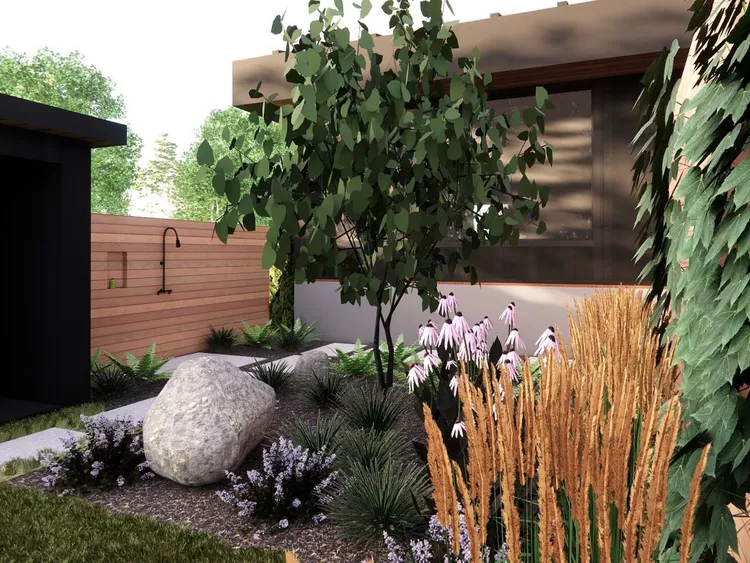
:max_bytes(150000):strip_icc():format(webp)/withlovemercedes-131483ee8eb34b048a321b10b310518d.jpg)
:max_bytes(150000):strip_icc():format(webp)/deliacreates-99c0137dc3d647f39624a052ccdffa73.jpg)
:max_bytes(150000):strip_icc():format(webp)/thekiwihome-42e07886b7e94edca3005e9ed7a63934.jpg)
:max_bytes(150000):strip_icc():format(webp)/apieceofrainbow2-eca17f94f7144663999050108f5b28e9.jpg)
:max_bytes(150000):strip_icc():format(webp)/abeautfilmess-281ddf434d0a4e7ebc7203b10b5ba44e.jpg)